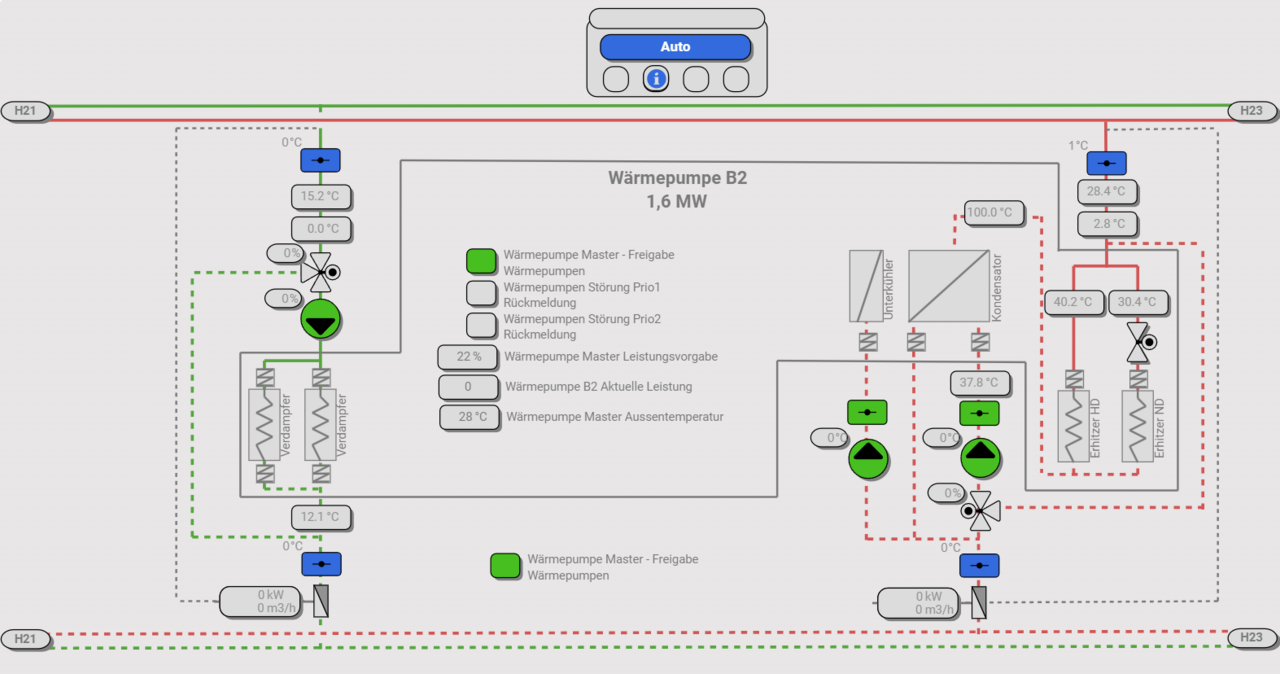
Building management system
The building management system, also known as the building automation system, is a key component of the EDL portal, which enables the control, monitoring and optimization of various technical building systems.
1. Importance of building management systems
The building management system plays a central role in the integration and control of systems such as heating, ventilation, air conditioning (HVAC), lighting, security technology and other technical building systems. It enables efficient and automated operational management, which leads to energy savings, increased comfort and better building performance.
The EDL portal offers a fully integrated control system. However, this is not a requirement. Other systems from competitors can also be integrated relatively easily into the EDL portal.
2. Main components of the building management system in the EDL portal
2.1. Sensors and actuators
- Sensors record data such as temperature, humidity, CO₂ content and movement, while actuators execute commands to control systems.
- The integration of various sensors and actuators enables comprehensive monitoring and control of technical building systems.
2.2. Control systems
- The control system forms the heart of the building management system and enables the programming, automation and monitoring of various systems.
- It consists of software and hardware components that are networked with each other and exchange data in order to optimize the operation of the systems.
2.3. Communication interfaces
- Communication interfaces enable the integration of external systems and data sources, including the EDL portal, to exchange data and coordinate actions.
- Protocols such as BACnet IP, Modbus TCP/RTU and OPC UA enable interoperability with various devices and systems.
2.4. User interfaces
- User interfaces allow users to access the building management system, visualize data, adjust settings and generate reports.
- They can include web-based dashboards, mobile apps or special software applications.
3. Functions of the building management system in the EDL portal
3.1. Monitoring and control
- Real-time monitoring and control of technical building systems to ensure optimum operation and comfort.
- Automated adjustment of parameters based on predefined schedules, operating modes or external conditions.
3.2. Energy optimization
- Identification of potential energy savings by analyzing consumption data and adjusting operating parameters.
- Automated load control and optimization to reduce energy consumption during peak times.
3.3. Security and alarm management
- Integration of security and alarm functions such as intrusion detection systems, fire alarm systems and emergency power supply (visualization only - no blue light functions).
- Automated alerting and notification of critical events to ensure building security and the protection of people and property.
3.4. Reporting and analysis
- Creation of reports on energy consumption, operating performance and alarm events to evaluate building performance.
- Analysis of trends and consumption patterns to identify optimization potential and develop preventive maintenance strategies.
4. Advantages of building management technology in the EDL portal
4.1. Energy efficiency
- Optimization of energy consumption through automated control and adjustment of operating parameters.
- Reduction of energy costs and CO₂ emissions through targeted load control and optimization.
4.2. Convenience and user experience
- Improved indoor climate and comfort through precise control of heating, ventilation and air conditioning.
- Adaptation of lighting and room conditions to the needs of users to increase satisfaction and productivity.
4.3. Safety and reliability
- Integration of security and alarm functions to ensure building security and the protection of people and property.
- Reduction of downtimes and malfunctions through proactive monitoring and maintenance of technical building systems.
4.4. Data-based decision-making
- Provision of comprehensive data and analyses to support data-based decisions to optimize building performance.
- Identification of trends and patterns for the continuous improvement and further development of building operations.
Conclusion
Building management systems, integrated with the EDL portal, provide a comprehensive solution for controlling, monitoring and optimizing building services systems.Overall, building management systems in conjunction with the EDL portal offer a wide range of benefits, including energy savings, improved comfort, increased safety and data-based decision-making. Through careful implementation and continuous optimization, operators can maximize their building efficiency and ensure sustainable operations management.

